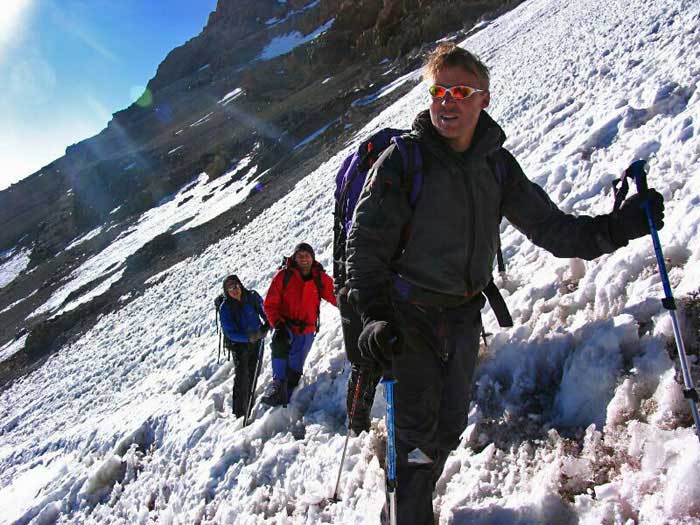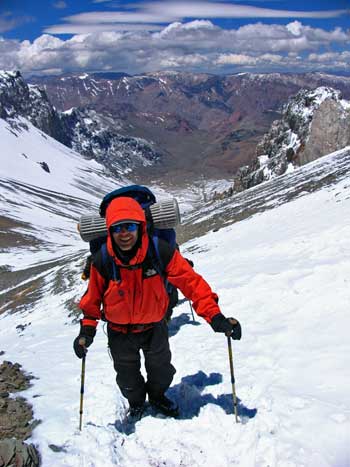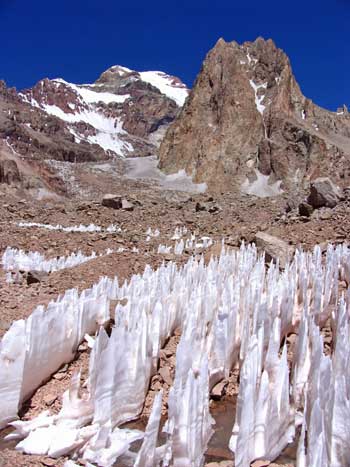Fitness Training for Aconcagua
Successful high altitude mountain climbing is largely intertwined with a high level of fitness. Your results can be greatly improved along with your safety margin, if you prepare yourself physically and mentally with lots of preparation training. By doing so you will bring down your chances of being in an accident or being affected by altitude sickness to a safe minimum. If nothing else, a good level of fitness will help to keep exhaustion at bay and will provide you with the strength that is needed to battle on during adverse weather conditions. If you choose us for your Aconcagua expedition we will help you prepare for the climb with training programmes and guidance.
Prior to the start of any training programme it must be stressed that although being fit is a great advantage in high altitudes, it does not guarantee that you will make it to the summit. Each individual adapts differently to the low oxygen pressure which is present at high elevations, whether they are in good shape or not. Your level of acclimatisation will depend on your body's ability to adjust to the dry, oxygen-poor air of Aconcagua and this is not something which can easily be predicted beforehand. If you have travelled to altitude before and it has not posed too much of a problem then the likelihood is that you will not be one of the more susceptible people to altitude sickness. Again, however, this is not guaranteed. We highly recommend that you follow the training itinerary offered by us which was designed to include an adequate amount of time for proper acclimatisation and consequently gives a better chance of reaching the peak. A conditioning programme before the climb will enable your body to prepare as much as is possible for the stress that is placed upon it at high altitude.
A key factor to succeeding on Aconcagua is judging how much psychological preparation one has undertaken beforehand. The rigours of this expedition are intense and almost every climber experiences some kind of low over the course of a few days at least once during the ascent. Although the most popular routes on Aconcagua are not 'technical' climbs, the high altitude, long days, extreme weather and the relatively uncomfortable conditions at the high altitude camps all make for a climb that should not be underestimated. Ideally, preparation for Aconcagua should involve the climbing of other high mountains and you should aim to gradually increase the altitude to which you can climb. Climbing Aconcagua will probably become a kind of self realisation trip. Getting to know your strengths and weaknesses during fitness training will help you mentally prepare, as will recognising what your personal goals and motivations are during the climb.

Six Month Training Programme
Heber Orona crafted the following schedule, which should be implemented six months prior to your climb. The programme has already proven effective for many of Aconcagua Treks’ clients who have successfully reached Aconcagua’s summit. By adjusting the intensities and weights accordingly, the training schedule can also be used as a basis for preparing for other, higher peaks. Training with a backpack or some kind of weight on your back will improve your fitness further and you will be required to carry your own backpack on Aconcagua. Start with a small weight and gradually increase it, but you must never run with a weight on your back. Towards the end of your training you should be comfortable walking for 6-8 hours with a heavy pack on, over challenging terrain. Remember that on Aconcagua your summit day could involve battling on for 12 hours at high altitude, if you’ve not built up your stamina, this could mean the difference between reaching the summit and falling just short!!
If you’re not in the habit of working out regularly, now is the time to start. Sticking to a daily workout regimen will not only get you in the physical condition necessary for the rigours of a big mountain, but it will also build the tenacity and dedication that will keep you going at 6000 metres in altitude. Even if you have a very busy life and you don’t get much spare time to train, if you are serious about climbing Aconcagua, getting fit beforehand is absolutely essential. Any exercise routine you get in to will need to be rotated to avoid burning out any muscle groups. Combine this programme with a healthy diet and plenty of sleep, and you’ll be as ready as you can be once the expedition date comes round. There are thousands of books and articles written about diets for specific nutrition or for fitness training. Search these out and read them, as they will likely give you some good tips. You will need to drink a lot of liquid on Aconcagua (a minimum of 4 litres per day). Drink two to three litres of water daily now so your body becomes accustomed to this extra fluid intake.
PRIOR TO EXPEDITION |
WEEKLY SCHEDULE |
|||||||||||||||||||||||||||||||||||||||||||||
|
|
Workout Details
Always do some warm up and cool down stretches to prevent unnecessary injury during your workout. Your muscles, ligaments and joints must be limbered up for exercise no matter how fit you are.
Aerobic Training - Intended to improve stamina and endurance and can include running (best), power walking, cycling, climbing, hiking, swimming, skiing, etc. for a minimum of 30 minutes per session.
Strength Training - Consider which parts of your body will be put under most strain during an ascent of Aconcagua and these are should be particularly strengthened. Your legs are the core area which will be pushed to the limits. Get your legs geared up to climbing by ascending steps and working out using step blocks which test your calves and thighs. Also focus strength training on arms, shoulders, back and abdominals (e.g., sit-ups, pull-ups, chin-ups, push-ups, dips). Each exercise should include three sets with as many reps as necessary to cause muscle failure on the last set. If weights or machines are available, include bent rowing, military presses and squats. Building up resistance through the use of weights can help increase anaerobic metabolism which encourages your muscles to work using stored carbohydrates rather than oxygen from the blood. Recreational Exercise - Anything you enjoy, including climbing, hiking, dancing, cycling, kayaking, etc. Using a combination of gym equipment and training in the great outdoors will create a balanced and well-rounded exercise programme.
Note: You should also consult your doctor prior to starting s strenuous exercise routine. In order to keep you motivated you may want to use a personal trainer who will come up with an original and personal workout plan that can be incorporated into your everyday life.


Acclimatisation on Aconcagua
Only thirty percent of people who try to climb Aconcagua will reach the peak. From our experience over the years, it is apparent that the same factors affect this percentage every season, one of these being altitude sickness. The effects of this illness can be minimised by having a well-planned acclimatisation schedule. Out of all climbers, those aged between 30 and 45 are often better at acclimatising due to the maturity of their nervous systems. Age is only one factor that influences acclimatisation, there are many others, most of which are entirely out of our control. Even the most experienced climbers may suffer from altitude sickness and it will not be apparent who is most susceptible until the climb is underway.
Most climbers of Aconcagua have been anticipating their expedition for months in advance and have been physically and mentally preparing themselves for a long time. It is understandable that once they arrive in Aconcagua Provincial Park they are very excited. However, getting worked up can be detrimental to a climber and it is in his best interests to remain calm and level-headed about the climb in order for the acclimatisation process to begin. Even the start out point is at a fairly high altitude (3000m) and it does not help to be getting flustered at this stage. Save the excitement for the summit and for the celebrations that will undoubtedly be occurring afterwards. Acclimatising to the thin air at high altitude is essential for a successful ascent and our expeditions give you sufficient time to adjust also providing extra days as contingency in case of bad weather. It is vitally important to fully acclimatise and although some companies offer shorter climbs on Aconcagua, unfortunately, this is often detrimental to the expedition’s chances of success.
